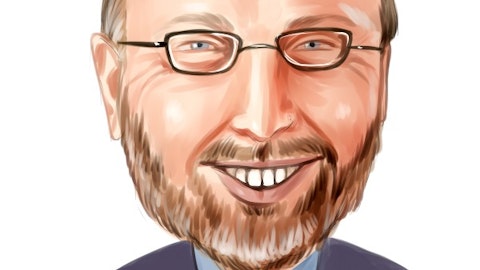Kenny Rocker: So we talked a little bit about it in terms of markets like our biofuels very bullish on our construction and autos, I mean, just set aside the strike that’s going on now. I talked about the business development win, but it’s still holding up from a demand environment. We need the strike to come back. And then we’ve talked about international intermodal. Now we’ve had a little bit of what I’ll call a seasonal bump, we’ll call it peak season. And you’ve heard me say we haven’t had one in a few years, so it’s nice to see one. But on the domestic side, also there’s just still a tremendous amount of over-the-road share that there. We think it’s in the low teens that’s in between out of Mexico and then the Mexico in terms of over-the-road share that we should be gathering.
Eric is out there getting up more improved products. We’ve got a lot of optionality out of Mexico. We see that as a growth engine. As some of these consumer-facing products improve. We’ve always said that we felt good about our petrochem business. Industrial chem is also included in that. So if you look across the line, there’s a lot of upside, and we’re very bullish on the volume growth is there.
Jim Vena: So Eric, why don’t you talk about it? Because the question is great. It’s — there’s no advantage of but that we have to grow the business. We have the price and take care of what’s happened to us inflation-wise and leverage our network, but productivity, what do you see your piece of it?
Eric Gehringer: Absolutely. We talked about productivity really differentiated into two buckets to some of our commentary already this morning, there’s no easy productivity, but this most straightforward productivity is when you get that volume, how do you leverage it on the existing network that we have, the existing trains we have the whole idea of being volume variable plus. The other bucket of productivity is how we actually do the work. So when we think about our locomotive shops, our mechanical shops or our engineering games, for example, on the non-op side, it’s a real challenge to them to say, hey, you still need to do the important work, how you do it more efficiently. So when we think about going into a locomotive facility and making sure that we balance the headcount to the exact number of locomotives they have to the forecasted number to being really thoughtful about how do we use that material in there to being thoughtful about how do we think about redoing cores.
I mean there’s infinite areas of opportunity within each one of our departments to be able to look deep into the business, deep into the work and really find those opportunities. To Jim’s point, it’s a little bit harder work than it was a few years ago, but it’s still work that we know how to do and work that we’ll be successful doing that.
Jim Vena: And I know neither one of them wanted to touch it, they always leave those things for me that people is going to be one. We look for cost savings on what our input costs are. And of course, it’s much more difficult on — in the inflationary place that we find ourselves in this country, but we’re going to look for every opportunity to use less so that we can save costs that way. And on headcount, absolutely, we’re going to use attrition to rightsize the company as much as we can to what we know now, we’ve identified where we want to get to. So it will be through attrition mostly, and we’ll move ahead from there. Thanks for the question.
Operator: The next question comes from the line of David Vernon with Bernstein. Please proceed with your question.
David Vernon: Hey, good morning, guys. So I wanted to talk a little bit about — I wonder if you could talk a little bit about the earnings leverage we should have from some of the intermodal agreements you guys are signing, obviously, the Falcon service, the partnership with NS. How should we be thinking about the profile from a margin perspective of that traffic coming on, particularly early here as truck rates remain low and it seems like intermodal companies are out there just counting the service to take some share? And then maybe a bigger picture, Jim, could you talk a little bit about how you see the competitive dynamic for UP changing post the CP/KC acquisition. We’ve heard a lot from Lance in the past on this, but I don’t think we’ve had a chance to hear you talk about how that acquisition creates risks or opportunities for Union Pacific from your perspective? Thank you.
Jim Vena: Okay, Jennifer.
Jennifer Hamann: Thank, David, for that question. You’ve heard us talk about margins before in terms of the — when we look at it, where you see some of the greatest margin pressure relative to our book of business is in that business that’s truck competitive. And we certainly are in a truck competitive market today. But that’s also our opportunity that you’ve heard us talk about in terms of tremendous growth, and we know that there’s leverage in margins from volume growth that can help drive greater productivity. And as we are building a better service product, certainly, as we provide better service, there’s a price for that service. And we look to price to that to be able to meet that customer demand. I don’t know, Kenny, if you want to add anything to that?
Kenny Rocker: No. The only thing I’d say is that as we’re looking in the current environment, we’re certainly keeping our customers competitive with mechanisms that we have in our contracts, and we are clear out about as the markets change, they’re stable now as they get a little bit more tighter, demand strengthen, we’ll see upside from a price perspective, which should show up in margin.
Jim Vena: And on the competitive dynamic and the specific example of CP/KC. So I think they’re a great railroad. I think they have a great network. I think they’re a leader, Keith, he’s a friend. I’ve known him for a long time, and he’s smart, knows out a railroad. So he knows how to balance safety service, asset utilization, cost control and developing is people, same thing as we do. So the competition is, and I like it. There’s nothing wrong with little competition. So I want to win, he wants to win. There’s no advantage of us that the CPKC, if it’s origination, the destination on their railroad we have a competitive disadvantage. But the advantage we have is we’ve got this great network. We go through 23 states. We serve the population in the US, we have fast access.
We have a 70-mile hour railroad. We’re fast. And if we have to be, if that’s what we sold was fast, we can do that. And you can see it when we move our parcel business as we’re doing and getting up to their peak period coming up towards Christmas. So all those things plus we have access into Mexico, broader access than one or two places. We go into the — into Mexico, from the West Coast all the way east in a number of locations. And we have a strong partner in FXC. And as you know, we own 26% of them and that helps us. So I’m excited. CP/KC is going to make it difficult and we’re going to make it difficult. Now I don’t chase price. This is not a price discussion. It’s about a service and access to markets and how we do it. And I’ll walk away from business if somebody wants to lower their price.





